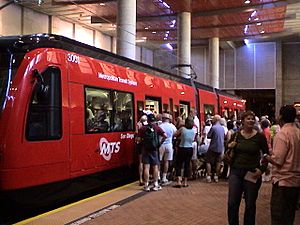Transportation in San Diego facts for kids
Transportation in San Diego consists of a variety of air, road, sea, and public transportation options.
Public transportation
San Diego is served by the San Diego Trolley, bus (operated by the San Diego Metropolitan Transit System), COASTER, and Amtrak. The trolley primarily serves downtown and surrounding urban communities, Mission Valley, east county, the coastal south bay, and the international border. A planned Mid-Coast line will operate from Old Town to University City along the Interstate 5 Freeway. There are also plans for a Silver Line to expand trolley service downtown.
The Amtrak and COASTER trains currently run along the coastline and connect San Diego with Los Angeles, Orange County, San Bernardino, Riverside, and Ventura via Metrolink. There are two Amtrak stations in San Diego, in Old Town and Downtown.
The bus is available along almost all major routes; however, a large number of bus stops are concentrated in central San Diego. Typical wait times vary from 15 to 60 minutes, depending on the location and route [1]. Trolleys arrive at each station every 7 to 30 minutes (depending on time of day and which trolley line is used). Ferries are also available every half hour crossing San Diego Bay to Coronado.
Public transportation statistics
The average amount of time people spend commuting with public transit in San Diego, CA, for example to and from work, on a weekday is 70 min. 23% of public transit riders, ride for more than 2 hours every day. The average amount of time people wait at a stop or station for public transit is 16 min, while 29% of riders wait for over 20 minutes on average every day. The average distance people usually ride in a single trip with public transit is 11.2 km, while 30% travel for over 12 km in a single direction.
Air
San Diego has two major international airports entirely or extending into its city limits:
San Diego International Airport, also known as Lindbergh International Airport or Lindbergh Field, is the primary commercial airport serving San Diego. It is the busiest single-runway airport in the United States, and is the second busiest single-runway airport in the world, only behind London Gatwick. It serves over 18 million passengers every year, and is located on San Diego Bay three miles (4.8 km) from downtown. There are scheduled flights to the rest of the United States, Mexico, Hawaii, the United Kingdom, Canada, and starting in December 2012, Japan. It serves as a focus city for Southwest Airlines. Voters rejected a proposal to move the airport to Miramar Marine Corps Air Station in November 2006.
Since December 9, 2015, the Cross Border Xpress terminal in Otay Mesa has given direct access to Tijuana International Airport, with passengers walking across the U.S.–Mexico border on a footbridge to catch their flight on the Mexican side. It is the only airport in the world with terminals located on the territory of two countries.
Other airports include Brown Field Municipal Airport (Brown Field) and Montgomery Field.
Sea
The Port of San Diego manages the maritime operations of San Diego harbor. Cruise ships arrive and depart from San Diego's cruise ship terminal on B Street Pier. Carnival Cruise Lines and Holland America have home port cruise ships in San Diego during the winter season. A second cruise terminal on Broadway Pier opened in 2010.
San Diego is home to General Dynamics' National Steel and Shipbuilding Company (NASSCO), the largest shipyard on the West Coast of the United States. It is capable of building and repairing large ocean-going vessels. The yard constructs commercial cargo ships and auxiliary vessels for the U.S. Navy and Military Sealift Command, which it has served since 1960.
Images for kids



